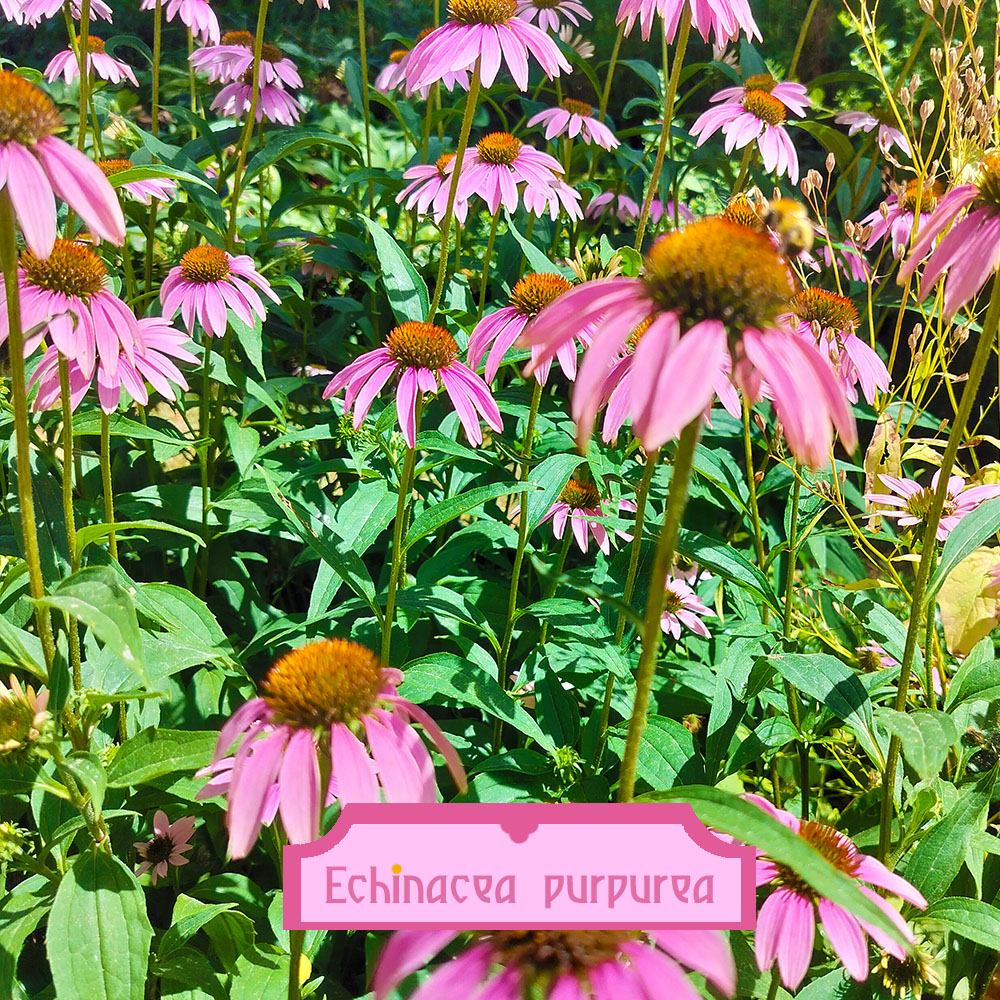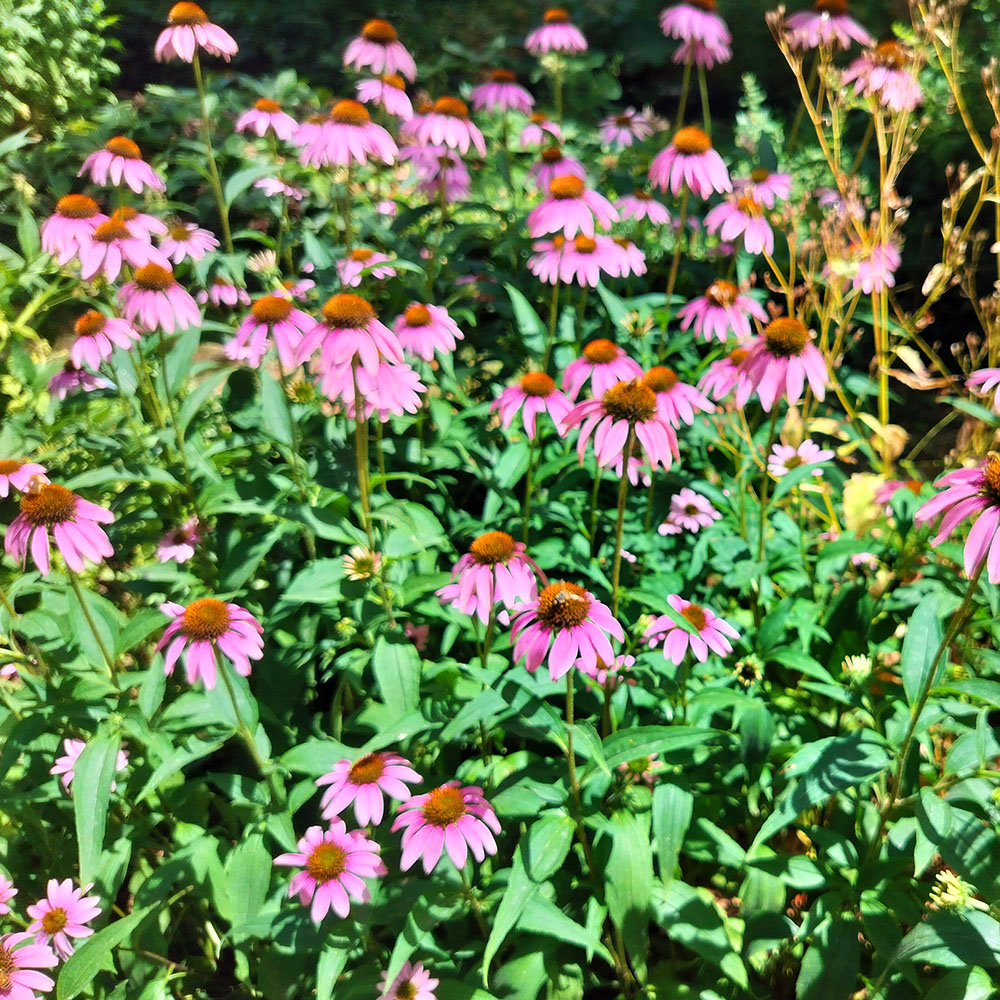No products in the cart.
Echinacea purpurea
A perennial with purple flowers all summer long
Rated 0 out of 5
0 customer reviews
4,90 €
Only 13 item(s) left in stock!
Tags: fleurs, longue floraison, perennial, persistant, plant, secheresse, soleil, vivace
SKU: pda137
Category: Bees and Butterflies, Bouquet, Distillations, Frost Hardy, Ground Cover, Make it Pop, Medicinal, Rewild, The Stunners

Echinacea purpurea
4,90 €
Only 13 item(s) left in stock!
Echinacea purpurea is a hardy, fast-growing perennial native to North America, widely cultivated for its ornamental, ecological, and medicinal value.
The flowers are cone-shaped and usually, but not always, purple in the wild. The blooms are long lasting – sometimes up to five months!
All sorts of bees are attracted to these flowers including Bumblebees, sweat bees, honey bees, the sunflower leafcutter bee, and the mining bee Andrena helianthiformis.
And butterflies! Notable butterflies include monarchs, swallowtail butterflies, and sulphur butterflies.
And birds! The plant produces achenes (a dry fruit) which is sought after by birds, particularly finches.
GARDENING TIPS: Echinacea purpurea
-
- SOIL: Prefers well-drained conditions and full sun, though it tolerates partial shade.
- DROUGHT TOLERANCE: Once established, Echinacea is drought-tolerant and resilient, capable of surviving in relatively poor soils where many perennials struggle.
- Looks great with Echinops ritro, Achillea Boule de Neige, Nepeta x faassenii
Learn more about gardening with Echinacea:
The Tales & The Botany: Echinacea purpurea
Echinacea means ‘spiny one’ in Greek, in reference to the spiny sea urchins ‘εχίνοι’ which the ripe flower heads of this genus resemble.
Extracts of the plant have shown to have immunostimulant properties and were cultivated commercially in Germany around 1939 and in Switzerland around 1950.
Although there are over 400 publications concerning the plant and dozens of preparations of Echinacea on the market, the true identity of many of the active principles still remains open.
Today, people use echinacea to shorten the duration of the common cold and flu, and reduce symptoms, such as sore throat (pharyngitis), cough, and fever.
It is one of the most widely studied medicinal plants, with over 400 scientific publications addressing its pharmacological potential.
Despite decades of study, the exact identity and mechanisms of all active compounds remain partially unresolved, making it a continuing subject of botanical and pharmacological research.
Ecology and Pollinators
Echinacea purpurea is an ecological powerhouse.
Its flowers attract a wide range of pollinators, including bumblebees, sweat bees, honeybees, the sunflower leafcutter bee, and the mining bee Andrena helianthiformis.
Butterflies are frequent visitors, with notable species including monarchs, swallowtails, and sulphur butterflies.
The dense flower heads provide a concentrated source of nectar and pollen, supporting pollinator populations over the long flowering season.
Birds are also drawn to Echinacea, particularly finches, which feed on the seeds (achenes) produced in late summer and autumn.
The spiny central cone protects the seeds until they are fully mature, allowing birds to feed gradually.
This dual role—providing nectar for pollinators and seeds for birds—makes Echinacea an important plant for supporting biodiversity in garden and wild landscapes alike.
Other Names
Eastern purple coneflower
Purple coneflower
Hedgehog coneflower
Origin
North America
| Weight | 0,5 kg |
|---|---|
| Flowering | July, August, September, October |
| Soil | Cool, Sandy |
| Exposure | Full Sun |
| Frost Tolerance | -20°C to -25°C |
| Size | 0.8m H x 0.4m W |
Reviews
0
Rated 0 out of 5
0 customer reviews
5
0
4
0
3
0
2
0
1
0
Only logged in customers who have purchased this product may leave a review.
Related Products
Vinca minor
Looping elegance and ability to form a low flowering ground cover
Looping elegance and ability to form a low flowering ground cover
Rated 0 out of 5
Sedum album
A low, multi-color ground cover.
A low, multi-color ground cover.
Rated 0 out of 5
Artemisia Valerie Finnis
A semi-evergreen, aromatic variation on the theme of Artemisia.
A semi-evergreen, aromatic variation on the theme of Artemisia.
Rated 0 out of 5
Glechoma hederacea
A sweet smelling ground cover, producing little blue flowers all summer long.
A sweet smelling ground cover, producing little blue flowers all summer long.
Rated 0 out of 5
Mentha x piperita ‘Chartreuse’
A spicy mint, known for its use in the production of liqueurs and herbal teas.
A spicy mint, known for its use in the production of liqueurs and herbal teas.
Rated 0 out of 5
Tradescantia Blushing Bride
Gorgeous blushes of pink and white that appear in the coldest nights.
Gorgeous blushes of pink and white that appear in the coldest nights.
Rated 0 out of 5
Kalanchoe daigremontiana
A toothy succulent from Madagascar, known as the Mother of Thousands.
A toothy succulent from Madagascar, known as the Mother of Thousands.
Rated 0 out of 5
Hellebore argutifolius
Winter flowering perennial with marbled blue-green leaves
Winter flowering perennial with marbled blue-green leaves
Rated 0 out of 5
Stachys byzantina
Silky white-grey leaves and tall striking flowers
Silky white-grey leaves and tall striking flowers
Rated 0 out of 5
Cerastium tomentosum var. columnae
A grey-green spreading ground cover from the mountains.
A grey-green spreading ground cover from the mountains.
Rated 0 out of 5
Euphorbia myrsinites
Known for its draping form of silver-gray foliage and radiant blooms.
Known for its draping form of silver-gray foliage and radiant blooms.
Rated 0 out of 5
Trachelospermum asiaticum ‘Ogon Nishiki’
Jasmine with colorful foliage and lovely white flowers in summer
Jasmine with colorful foliage and lovely white flowers in summer
Rated 0 out of 5
Hieracium maculatum Leopard
A native perennial with blue-green leaves and a tall yellow flower
A native perennial with blue-green leaves and a tall yellow flower
Rated 0 out of 5
Potentilla anserina
A distinctly silvery, silky and lacy perennial.
A distinctly silvery, silky and lacy perennial.
Rated 0 out of 5
Tanacetum densum subsp amani
A shrublet composed of soft, finely divided silvery gray-white leaves.
A shrublet composed of soft, finely divided silvery gray-white leaves.
Rated 0 out of 5
Euphorbia cyparissias Clarice Howard
A Euphorbia that resembles a soft little cyprus tree
A Euphorbia that resembles a soft little cyprus tree
Rated 0 out of 5
Erigeron kavinskianus
A daisy-like carpet of flowers
A daisy-like carpet of flowers
Rated 0 out of 5
Melissa officinalis
A perennial plant in the mint family that is adored by bees, royal families and tea drinkers.
A perennial plant in the mint family that is adored by bees, royal families and tea drinkers.
Rated 0 out of 5
recent view product
Thymus camphoratus
An upright shrub with white velvet leaves and an aroma of camphor and summer.
An upright shrub with white velvet leaves and an aroma of camphor and summer.
Rated 0 out of 5
Daphne laureola
Dark green leaves that prefer the dry shade
Dark green leaves that prefer the dry shade
Rated 0 out of 5
Crassula muscosa
A succulent with thin, spiralling square leaves
A succulent with thin, spiralling square leaves
Rated 0 out of 5
Tanacetum vulgare Isla Gold
A bright yellow medicinal and fragrant perennial herb
A bright yellow medicinal and fragrant perennial herb
Rated 0 out of 5
Chrysanthemum Dernier Soleil
A perennial with large yellow flowers tipped with coppery-orange hues
A perennial with large yellow flowers tipped with coppery-orange hues
Rated 0 out of 5














































There are no reviews yet.